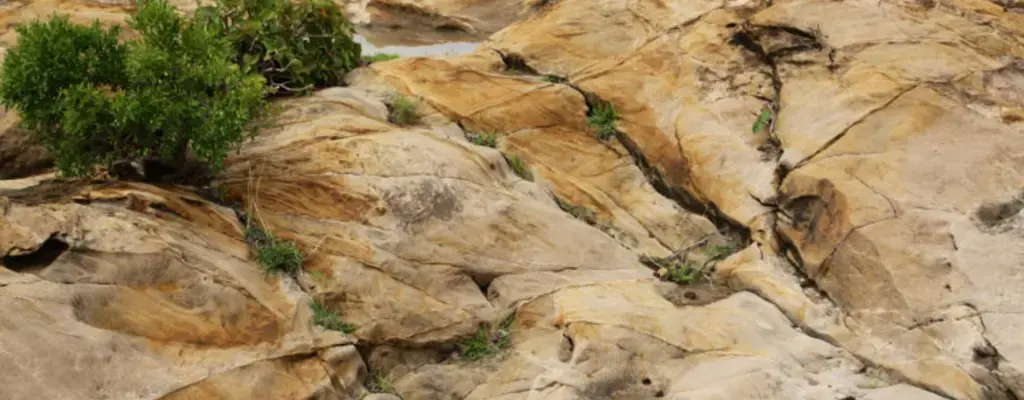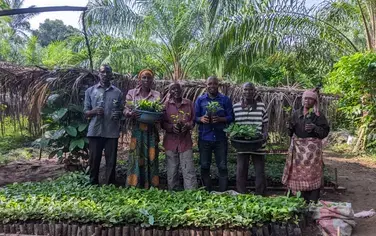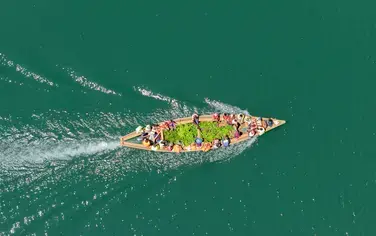With its second annual conference upcoming, the ambitious African Forest Landscape Initiative has already begun to change the face of land use in Africa
This article is a part of the Global Landscapes Forum coverage of the AFR100 Second Annual Partnership Meeting in Niamey, Niger, 26-28 September.Leaders from the African continent and beyond gathered in Niamey, Niger this past week to advance one of the most ambitious climate change mitigation and adaptation initiatives across the globe.
The African Forest Landscape Restoration Initiative (AFR100) is a country-led effort to bring 100 million hectares of degraded and deforested land in the African continent into reforestation by 2030. It’s administered by the African Union’s New Partnership for African Development (NEPAD), supported by a number of technical partners, and financed by the German Federal Ministry for Economic Cooperation and Development (BMZ) and the World Bank, along with private sector investors. Twenty-four African countries have signed on since its inception in 2015, and 80 million hectares have already been pledged – an area twice the size of Germany.
Mamadou Diakhité, Team Leader for Sustainable Land and Water Management at NEPAD, says “we’re hopeful that we’ll reach the 100 million hectares [of land pledged] in the next few months.” At this year’s Second Annual Partnership Meeting in Niamey, he says, the aim is to progress the agenda further with the decisive call to action “From Commitment to Implementation.”
Restoring degraded and deforested land is key to mitigating the impacts of climate change, and Africa has the largest reforestation opportunity of any continent in the world, with over 700 million hectares of degraded land. But African countries are also some of the least historically responsible for climate change. So why show leadership and pursue this ambitious target, when countries with the lion’s share of historic responsibility may not yet be stepping up in similar ways?
BENEFITS ON THE GROUND
For Erick Ogallo of the youth-led Kenya-based forest restoration NGO Kijani (one of AFR100’s technical partners), the reasons to act are obvious when he travels from Nairobi, where he works, to the small rural village that he grew up in. “I’m motivated by seeing the way things are changing,” he says. “And they’re changing very fast.”
In recent years, tree and bush cover has all but disappeared from the area. There’s very little firewood available for fuel, or material for building. Most concerning, says Ogallo, is that water catchment areas are being affected. This considerably impacts daily life, as well as agricultural practices – the mainstay of the Kenyan economy. “So if we don’t reforest, we’re not going to have food. We are doing this to save all of our lives.”
At wider scales, the story is similar. Every year, nearly three million hectares of forest are lost in Africa, and 65 percent of land is affected by degradation. As well as environmental impacts, there are serious economic implications. It’s estimated that on average, three percent of GDP is lost annually from soil and nutrient depletion on cropland within the continent.
And climate change is contributing to lowering crop yields, making the situation even worse – especially for rural, smallholder farmers and households, who depend on stable weather patterns, healthy soils and tree cover, and water to maintain their livelihoods.

34 wind turbines produce 51 Mega Watts (MW) of electricity in Adama, Ethiopia. Photo by Ollivier Girard/CIFOR
When forests are restored, soil fertility rises and agricultural productivity is enhanced. Farmers can diversify their livelihoods, building improved food security in the face of climactic fluctuations, and contributing to economic growth. As Peter Ndunda, senior associate on AFR100 at the World Resources Institute, points out, “the biggest potential for development for Africa is its natural resources. And we’re now at that moment where the continent needs to think critically about what the best options are for managing, restoring and use of these natural resources, for current and future generations.”
The benefits of reforestation for rural women can be particularly significant, given that in many parts of Africa they tend to be the ones collecting firewood and water on a daily basis. As Ndunda explains, “if the river stops flowing, and if they have to walk longer and longer distances [to gather what they need] then that’s time that they can’t use to do other things. So it makes them poorer and poorer.” Worse still, he says, children often have to skip school to help gather these diminishing resources, contributing to intergenerational poverty.
If done well, says Diakhité, reforestation processes can address this issue directly, and contribute to women and young people’s livelihoods further by creating ‘green’ jobs for them in the rural communities in which they live.
So, it’s important that these processes are participatory and work with vulnerable people in empowering ways, adds Anna Rother of German development cooperation agency GIZ, another technical partner in AFR100. After all, the Forest Landscape Restoration (FLR) approach driving the initiative “is not just about protecting nature – it’s a people-centered approach.”
This way of working requires considerable flexibility, as well as sound cross-sector collaboration and communication, explains Magda Lovei, Practice Manager at the World Bank. “To have the greatest impact, we need to work across the sectors that shape Africa’s landscapes, and adapt a broad menu of solutions to each context. This assumes that people work at different levels simultaneously,” she says. It also highlights the importance of opportunities like the Niamey conference for member countries to learn from each other along the way and take better practice forward, says Rother.
A NEW NARRATIVE: BUILDING ON AFRICAN SUCCESS
Why do this now? According to Ndunda, “we are at a point in the African continent where there’s a huge need for a positive narrative, and not just one for the sake of it, but one that is based on actual things that are happening on the ground.” And forest restoration already has a strong tradition of success in Africa at smaller scales: success that, he believes, “presents opportunities for the continent to rise. Opportunities for the countries to find solutions, to catalyse what made those successes work, to scale-up.”
AFR100, then, provides an important platform to stimulate momentum and transformative action, at a time when it can tie in usefully to international climate change mitigation agreements such as the Paris Declaration, the Bonn Challenge and the Sustainable Development Goals, says Lovei.
Ogallo agrees: “AFR100 has been useful for showing the world that forest matters. African forest matters. In terms of the environment, we’re all one universe – what we do in Africa affects other countries. So we need to work together.”
TO 2030 AND BEYOND
Of course, “2030 is just a number,” Ogallo reminds us, and whatever change is achieved in the next 13 years needs to be sustainable beyond that timeframe. What will help? Beyond technical assistance and financial expertise, supporting and inspiring bold, courageous leadership by restoration champions at multiple scales seems crucial, says Diakhité. So a key question for the conference to address, says Ndunda, is this one: “How do we mobilize our restoration champions to ensure that they have what it takes to lead the movements? We have seen some of them do amazing work with so little. Now just imagine, if they had more support, what they would be able to do!”
This coverage was made possible by the New Partnership for Africa’s Development (NEPAD), the German Federal Ministry for Economic Cooperation and Development (BMZ), and German Society for International Cooperation (GIZ).
Interested in restoration? This and many other interrelated topics will be on the agenda at the Global Landscapes Forum in Bonn: December 19-20, 2017.




